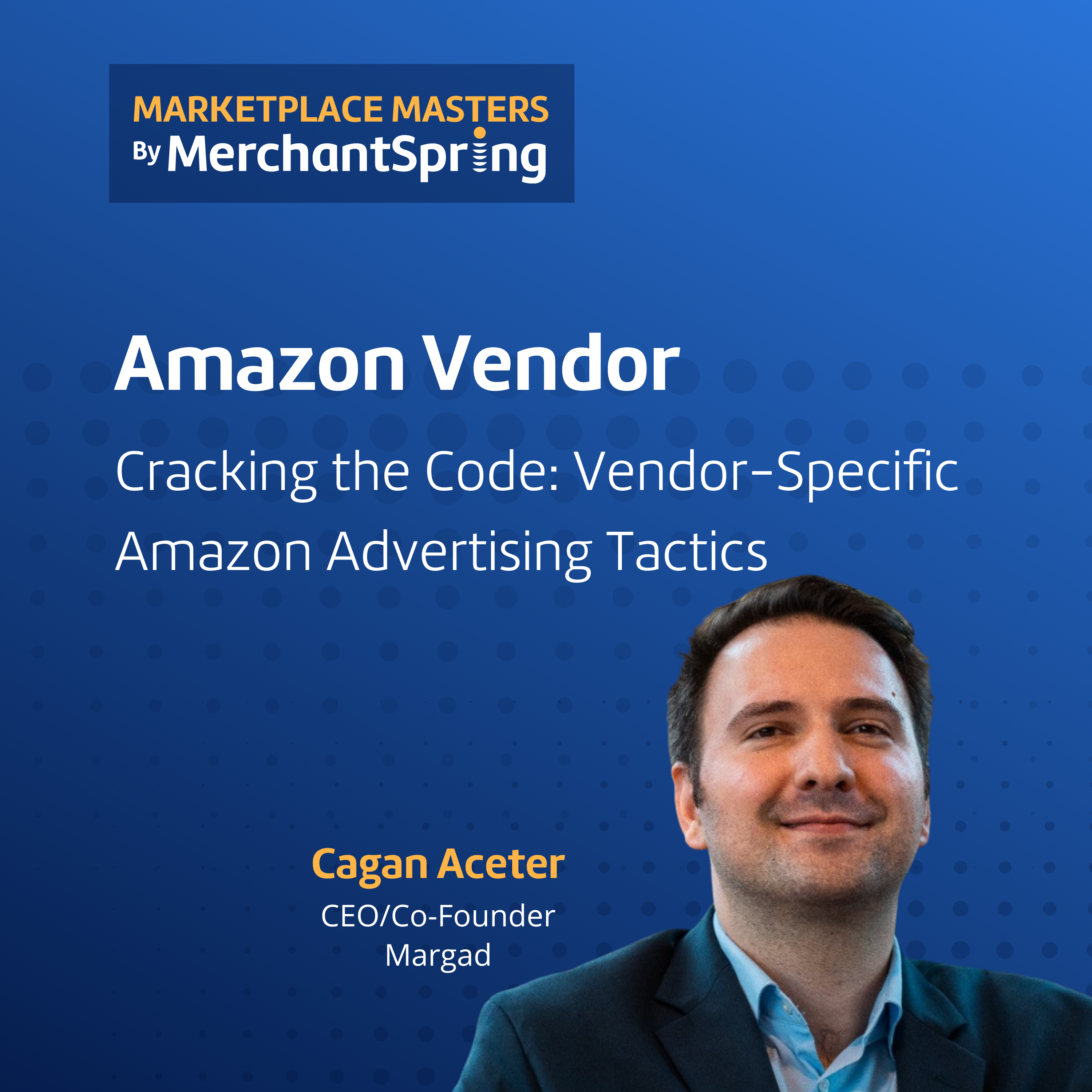Decoding Success: Unleashing Vendor-Specific Amazon Advertising Strategies!
Overview
In this episode, Cagan Aceter of Margad joined Paul Sonneveld and explored how to unravel the intricacies and distinctions that vendors must keep in mind to orchestrate advertising campaigns on the Amazon platform.
Vendors face unique advertising challenges
Vendors on the Amazon platform encounter distinct advertising hurdles that demand tailored strategies for effective navigation. One such challenge revolves around the absence of price control, a facet that sets vendors apart from sellers. Unlike the latter, vendors relinquish control over pricing to Amazon, directly impacting conversion rates. While this lack of autonomy can restrict competitive pricing strategies, it also removes the burden of setting prices solely for advertising purposes.
“…there are like four points which are very important for vendors. The first one is you don't have the price control… the second one is the attribution window… And third one for me is the unit economics… And, the fourth one is a very hard issue, is the dormant account.” - Cagan Aceter, CEO/Co-Founder, Margad
Another hurdle for vendors lies in the attribution window discrepancy. Unlike sellers, who operate within a seven-day attribution window, vendors contend with a 14-day timeframe. This disparity complicates reporting and analytics, especially in fast-paced environments where swift results are imperative. Consequently, vendors must remain cognizant of this discrepancy and adapt their advertising approaches accordingly to effectively measure campaign performance.
Unit economics emerges as yet another significant challenge for vendors, primarily stemming from cost prices and profit margins. Unlike sellers who retain the liberty to dictate prices, vendors may grapple with profitability concerns, necessitating additional funding if advertising campaigns fail to yield profit. Striking a balance between advertising expenditures and profit margins poses a multifaceted dilemma for vendors, highlighting the intricacies of financial management in advertising endeavours.
Leverage Amazon's price matching.

Vendors on Amazon have a potent tool at their disposal in the form of the platform's price-matching feature. This system, which operates three times daily at random intervals, serves to maintain competitive integrity and thwart fraudulent practices. Leveraging this feature enables vendors to ensure their pricing remains attractive and competitive, a crucial factor in driving customer interest and conversions.
The impact of Amazon's price-matching feature on conversion rates cannot be understated. Vendors can capitalize on price drops by increasing their advertising spend, thereby anticipating heightened conversions without sacrificing profit margins. Unlike sellers who may need to compromise margins to match prices, vendors can strategically adjust advertising budgets to align with pricing fluctuations, potentially bolstering sales and customer engagement.
Conversely, vendors must remain vigilant of extended delivery promises associated with their products. In such instances, it's advisable to scale back advertising spend, as directing traffic to products with longer delivery times may yield inefficiencies in conversion rates. By reallocating resources away from products with extended delivery promises, vendors can focus efforts on more promising opportunities, optimizing their advertising campaigns for maximum impact.
Furthermore, vendors can utilize Amazon's price matching feature not only for their own products but also to monitor and respond to competitor activity. Observing price fluctuations or extended delivery promises from competitors can inform more aggressive targeting strategies. By capitalizing on competitor weaknesses or delays, vendors can potentially capture a larger market share and bolster their own conversion rates, further solidifying their position on the platform.
Metrics for measuring Amazon advertising success
When assessing the effectiveness of Amazon advertising campaigns, vendors must prioritize key metrics like Vendor ACOS and Vendor TACOS. These metrics offer insights into the advertising cost of sale (ACoS) relative to products sold by Amazon, providing a clearer picture of campaign performance. Calculating Vendor ACOS involves dividing ad spend by total peacocks, while Vendor TACOS is determined by dividing total expense by total PCOGS. Analyzing these metrics on a product level is crucial due to varying margins across different products.
“I guess the one most important thing is what we called is vendor ACOS. And also vendor TACOS… So I would say this is the most important metric for the advertising for vendors. And I suggest to break down this on the product level. Because each product has like different margins, so it will be beneficial for our users. ”- Cagan Aceter, CEO/Co-Founder, Margad
Determining the total advertising cost of sale (TACOS) involves various approaches, such as calculating it based on the value of purchase orders (sell-in) or considering shipped cogs (cost of goods sold). Both methods have their merits, but excluding ordered product sales (OPS) is essential for accuracy. Each approach offers unique insights into campaign performance, allowing vendors to make informed decisions based on their advertising objectives.
When analyzing these metrics, it's advisable to look at a longer timeframe to account for fluctuations in purchase orders and ensure a representative view of advertising performance. Using an average figure for each product can also aid in calculating the Vendor ACOS accurately. While different measures have their benefits and drawbacks, selecting the most suitable metric is crucial for optimizing advertising strategies and achieving success on the Amazon platform.
"Approach business with a playbook."
The podcast episode underscores the critical role of employing a playbook approach to thrive on the Amazon platform. Through an interview with an experienced expert, Cagan in Amazon vendor management, insights and practical tips are shared, derived from real-world experiences.
“For the business cases, the first one is like the business as usual… And the second one is if you want to increase your market share, you need to have a different plan. A third one is like, it is very important. This is for the event periods… And the last one Paul would be is a new selection launch. I guess if you are launching a new product, new ASIN, you need a very specific strategy, very specific budget and advertising roadmap in order to be successful for that.”- Cagan Aceter, CEO/Co-Founder, Margad
According to Cagan, four key pillars form the foundation of successful business strategies on Amazon. Firstly, maintaining sales at a consistent level, referred to as the "business as usual" scenario, demands a well-defined plan for advertising and overall business strategy. Secondly, increasing market share requires a different approach, including sponsored display or DSP usage and leveraging Amazon attribution to drive external traffic.
Tailored strategies for event periods like Black Friday or Prime Day form the third pillar, emphasizing the need for specific plans to capitalize on high-traffic periods effectively. Lastly, launching new products or offerings constitutes the fourth pillar, necessitating a meticulously planned strategy, budget, and advertising roadmap for a successful introduction to the market.
The importance of having a playbook for each of these pillars is emphasized by the expert, highlighting its role in making data-driven decisions, optimizing advertising strategies, and adapting to varying scenarios. Successful vendors are those who embrace this approach, while those lacking a strategic playbook are at a disadvantage.
Approach advertising holistically, track metrics

A key focal point is the holistic approach to advertising and the necessity of tracking key metrics. The guest speaker stresses that advertising should not exist in isolation but rather be integrated seamlessly into the broader business strategy. Vendors must comprehend the various risks and factors influencing profitability on Amazon, necessitating vigilant tracking of key metrics to facilitate informed decision-making.
Cagan advocates for a strategic boost in retargeting budgets, particularly for high average selling price (ASP) products, in the lead-up to Christmas. This tactic, while short-term in nature, proves effective in capitalizing on the heightened purchasing propensity for premium items during the holiday season. Nonetheless, the speaker underscores the importance of not fixating solely on retargeting or short-term maneuvers, urging vendors to adopt a holistic perspective that aligns advertising efforts with overarching business objectives.
By meticulously tracking key metrics such as click-through rates, conversion rates, and return on investment (ROI), vendors gain invaluable insights into the performance of their advertising endeavours. These metrics serve as benchmarks for assessing campaign effectiveness, identifying areas for improvement, and guiding data-driven decisions to optimize advertising strategies.
Furthermore, Cagan emphasizes the indispensable role of a comprehensive playbook, equipped with specific strategies tailored for diverse scenarios like maintaining business as usual, expanding market share, navigating event periods, and launching new selections. This playbook-centric approach ensures preparedness and enables vendors to make strategic decisions aligned with their unique goals and objectives.















Add a Comment